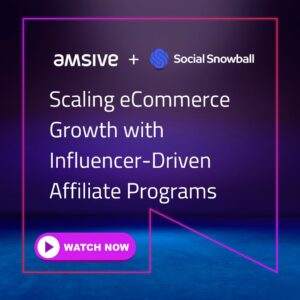Social media ROI challenges modern consumer brands. Within its sphere of digital marketing, it’s one of the top seven marketing challenges identified by marketers via Hubspot. While marketing budgets have swelled and then tightened within the last few years, what was reasonable to achieve before 2020 simply doesn’t garner the same results.
In the current social ecosystem, can a consumer brand outpace its increasing number of competitors? Yes, but it takes strategy. Great results with actionable business outcomes happen every day for consumer brands that, instead of chasing the easiest of wins, sustainably grow their business through smarter brand storytelling led by data and actionable insights.
Want to win in today’s social ecosystem? Focus on these three areas — and achieve real results.
Step change your organic social strategy
The value of organic social has risen with the increase in social media usage. As more brands diversify their advertising through a growing variety of social advertising options, your organic content can’t be sidelined or forgotten. Ads play a key role in your social strategy, and organic social does, too.
A strong organic social presence ensures consumer brands can:
- Consistently share core tenets of your brand story
- Create deeper connections with target audiences
- Remain an engaged member within the right social media communities and conversations
- Stay ahead of the curve through social listening
- Speak directly with brand loyalists, questioners, and more with adept community management
Sustainable organic social strategy looks long-term, adapting to the evolving social media habits and behavior of target audiences.
“Social media content has always been perceived as having this tiny shelf-life…
Jein Funk, Creative Director
Going forward, we’re going to see social strategies that prioritize long-term utility over in-the-moment relevancy— and that’s a good thing. It means brands are going to have space to really prove their value and their expertise instead of feeling like they always need to be wedging their way into the latest trending conversations.”
Successful social strategy hinges on a connected confluence of organic, influencer and paid social — the right mix of user-generated content (UGC), ads, and organic posts and videos.
In just one example, a Progressive Grocer study found that “53% of Gen Z respondents said they find inspiration for new food through TikTok.” Its findings also stated, “More than half of all Gen Z respondents believe what they eat is indicative of who they are as a person, and 47% of respondents said that in the next few years, they will prioritize more mental health-focused eating.
Those aren’t just hollow words for consumer brands. It’s a pronouncement of the power brands can have in social spaces with up-and-coming audiences. Rising generations of consumers demand more connection and (the right) communication from brands — intuitive, conversational, and in the moment. Organic social, a constant source of conversation between consumer brands and their current and future customers within key social communities, plays a pivotal role in building these relationships.
A step beyond the solid foundation of organic social content is the strategic use of influencer marketing within your consumer brand’s relationship building.
Enhance your influencer marketing
Influencer marketing and the UGC it creates is another foundational element in competitive social strategies. Go back a decade or more, when Meta (then Facebook) was in its heyday, and a business could create a page, share a few posts, and suddenly gain thousands of followers. Back then, paid media was used to supercharge the results businesses could gain through organic posting.
These days, ads aren’t an addition but a necessity to cut through the noise on key social platforms. At the intersection of organic and paid social is influencer marketing. Influencer campaigns, especially on Instagram and TikTok, deliver exceptional results by leveraging the trusted voices of those with thousands of followers within your target audience. And a whopping 90% of marketers believe that influencer marketing is effective, as surveyed in a 2022 Influencer Marketing Hub survey.
Through influencers, consumer brands can extend their reach to key audiences with authentic, trustworthy storytelling on social.
Would consumers, at key moments of their customer journey, prefer an in-feed ad announcing the latest product in a much-beloved product line? Or an engaging video message from someone they already follow sharing the same news, with, additionally, their inside tips and personal thoughts on this latest reveal? The majority of social users in key moments want the latter. Knowing when – and how — to leverage influencer content is the difference between real business ROI and immeasurable campaign results.
Consider a multi-tiered strategy that includes two key components. First, employ an ‘always-on’ brand ambassador strategy to consistently deliver brand messaging to raise and maintain your share of voice within social ecosystems. Then, use episodic and larger influencer campaigns that support key brand initiatives, important retail customers, and/or seasonal pushes as part of your media and marketing mix for these initiatives.
All influencer marketing efforts must be amplified with paid media support launched from influencers’ accounts to drive maximum program reach, engagement, and traffic — achieving KPIs and greater return on influencer investments.
Amplify results with paid media
What role, then, does paid advertising play in today’s social ecosystem? Paid media magnifies consumer brands’ stories, ensuring targeted ads reach the right people — in just the right moment. While investment and subsequent results vary from platform to platform, paid media, when done strategically, boosts campaign ROI. With paid media, brands can magnify storytelling, target highly specific audiences, and scale reach.
With mobile video consumption 17x higher than ten years ago, paid media on social must include motion and video. Brands continue to increase spending on video as brand marketers know that video creates big wins — and higher conversion KPIs. For example, video ads offer 2X higher audience engagement on LinkedIn.
In the highly crowded and competitive social sphere, paid media is essential for being seen at all. If your brand is new to a platform or needed to expand its reach, gaining visibility can be achieved through a combination of all of the above efforts.
The possibilities are endless. Success comes from developing and then optimizing the best mix of organic, influencer, and paid social for your brand.
This social trifecta, each with its own merits as an individual tactic, becomes a powerful business-building strategy when working together.
Discover more consumer brand-building insights
From storytelling to measurement, consumer brands looking to gain eyes – and customers – have ample opportunities if they know where to look. Explore six fundamental pillars of digital marketing for consumer brands to establish a “hack-free” digital foundation that drives sustainable brand growth.
Whether the majority of purchases happen on or offline, consumer brands need a strong digital foundation to effectively tell their story and engage consumers, whose customer journey starts online. Brands in the health and wellness, beauty, and over-the-counter categories can win when they intuitively show up for consumers across their digital ecosystems and purchase journeys. So, the right people can view, engage with, and act on the right social content — uniquely built for the moment.






